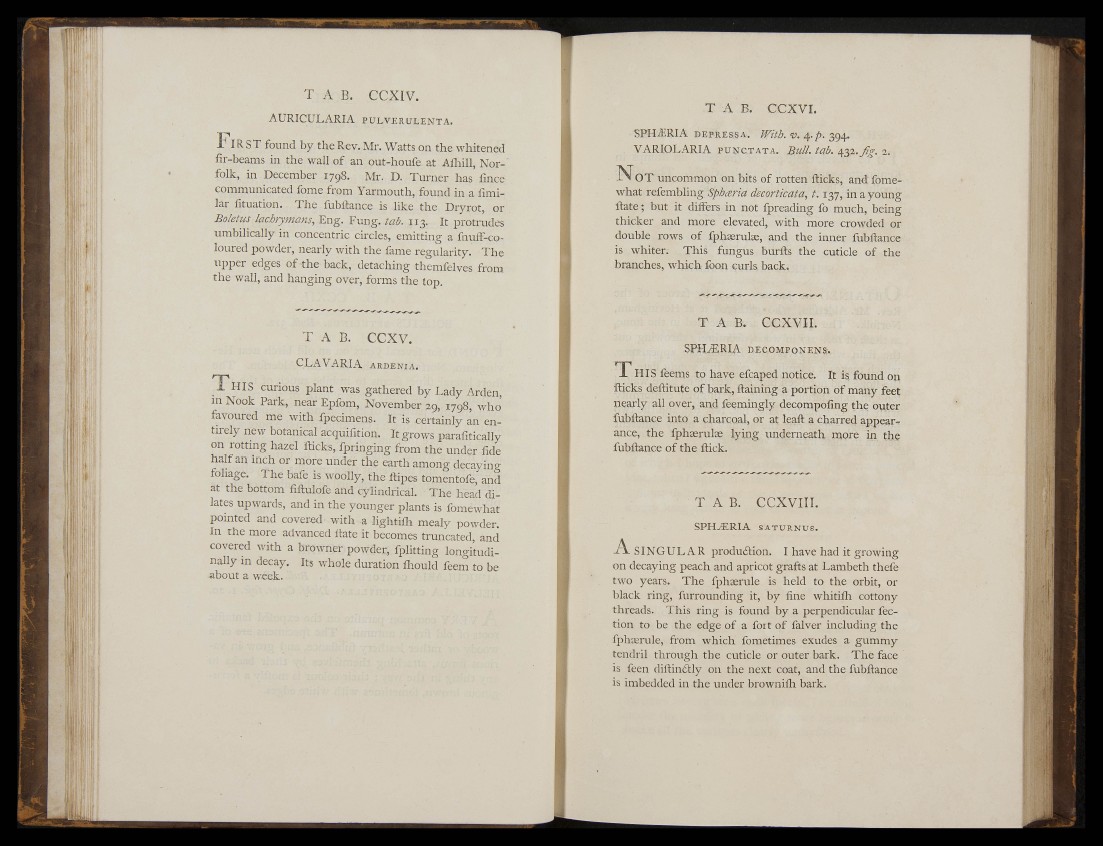
mi
' Ir
ì
, iiìl^i
T A B. CCXIV.
AURICULARIA pulverulenta.
F i r ST found by the Rev. Mr. Watts on the whitened
fir-beams in the wall of an out-houfe at Ailiill, Norfolk,
in December 179S. Mr. D. Turner has fince
communicated fome from Yarmouth, found in a fimilar
fituation. The fubftance is like the Dryrot, or
Boletus lachrymans. Eng. Fung. tab. 113. It protrudes
imibilically in concentric circles, emitting a fnvifF-coloured
powder, nearly with the fame regularity. The
upper edges of the back, detaching themfelves from
the wall, and hanging over, forms the top.
T A B. CCXVI.
SPHiiRIA DEPRESSA, M/z^. «y. 4 . 3 9 4 .
VARIOLARIA punctata. Bull tab. 432.^?^. 2,
N o t uncommon on bits of rotten flicks, and fomewhat
refembling Spharia decorlicata, 1.137, in a young
liate ; but it differs in not fpreading fo much, being
thicker and more elevated, with more crowded or
double rows of fphasrulce, and the inner fubilance
is whiter. This fungus burfts the cuticle of the
branches, which foon curls back.
ai
Ai
H: I
T A B. CCXV.
CLAVARIA ARDENIA.
T h i s curious plant was gathered by Lady Arden
in Nook Park, near Epfom, November 29, 1798, who
favoured me with fpecimens. It is certainly an entirely
new botanical acquifition. It grows parafitically
on rotting hazel flicks, fpringing from the under fide
half an inch or more under the earth among decaying
foliage. The bafe is woolly, the ñipes tomentofe, and
at the bottom fiilulofe and cyhndrical. The head dilates
upwards, and in the younger plants is fomewhat
pointed and covered with a lightiili mealy powder.
In the more advanced ilate it becomes truncated, and
covered with a browner powder, fplitting longitudinally
in decay. Its whole duration fl:.ould feem to be
about a week.
T A B. CCXVIL
SPH^RIA DECOMPONENS.
r-p
X HIS feems to have efcaped notice. It is found on
Hicks deflitute of bark, flaining a portion of many feet
nearly all over, and feemingly decompofing the outer
fubflance into a charcoal, or at leaft a charred appear-r
ance, the fphasrulae lying underneath rnore in the
fubflance of the flick.
T A B . CCXVIII.
SPH^RIA SATURNUS.
A SINGULAR produ¿lion. I have had it growing
on decaying peach and apricot grafts at Lambeth thefe
two years. The fphaerule is held to the orbit, or
black ring, furrounding it, by fine whitiih cottony
threads. This ring is found by a perpendicular fection
to be the edge of a fort of falver including the
fphterule, from which fometimes exudes a gummy
tendril through the cuticle or outer bark. The face
is feen dillinólly on the next coat, and the fubftance
is imbedded in the under brownifli bark.
t
; i
J l : '
!i.
f